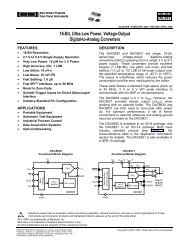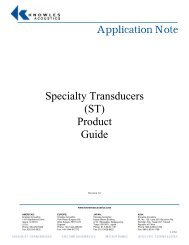AD7714* 3 V/5 V, CMOS, 500 µA Signal Conditioning ADC - dreamm
AD7714* 3 V/5 V, CMOS, 500 µA Signal Conditioning ADC - dreamm
AD7714* 3 V/5 V, CMOS, 500 µA Signal Conditioning ADC - dreamm
Create successful ePaper yourself
Turn your PDF publications into a flip-book with our unique Google optimized e-Paper software.
AD7714<br />
Gain<br />
Table XIV. Input Sampling Frequency vs. Gain<br />
Input Sampling Freq (fs)<br />
1 f CLK IN /64 (38.4 kHz @ f CLK IN = 2.4576 MHz)<br />
2 2 × f CLK IN /64 (76.8 kHz @ f CLK IN = 2.4576 MHz)<br />
4 4 × f CLK IN /64 (153.6 kHz @ f CLK IN = 2.4576 MHz)<br />
8 8 × f CLK IN /64 (307.2 kHz @ f CLK IN = 2.4576 MHz)<br />
16 8 × f CLK IN /64 (307.2 kHz @ f CLK IN = 2.4576 MHz)<br />
32 8 × f CLK IN /64 (307.2 kHz @ f CLK IN = 2.4576 MHz)<br />
64 8 × f CLK IN /64 (307.2 kHz @ f CLK IN = 2.4576 MHz)<br />
128 8 × f CLK IN /64 (307.2 kHz @ f CLK IN = 2.4576 MHz)<br />
Burn-Out Current<br />
The AD7714 contains two 1 µA currents, one source current<br />
from AV DD to AIN(+) and one sink from AIN(–) to AGND.<br />
The currents are either both on or off depending on the BO bit<br />
of the Mode Register. These currents can be used in checking<br />
that a transducer has not burnt-out or gone open circuit before<br />
attempting to take measurements on that channel. If the currents<br />
are turned on, allowed flow in the transducer, a measurement<br />
of the input voltage on the analog input taken and the<br />
voltage measured is full scale then it indicates that the transducer<br />
has gone open-circuit; if the voltage measured is zero, it<br />
indicates that the transducer has gone short-circuit. For normal<br />
operation, these burn-out currents are turned off by writing a 0<br />
to the BO bit. For the source current to work correctly, the applied<br />
voltage on AIN(+) should not go within <strong>500</strong> mV of AV DD .<br />
For the sink current to work correctly, the applied voltage on<br />
the AIN(–) input should not go within <strong>500</strong> mV of AGND.<br />
Bipolar/Unipolar Inputs<br />
The analog inputs on the AD7714 can accept either unipolar or<br />
bipolar input voltage ranges. Bipolar input ranges do not imply<br />
that the part can handle negative voltages on its analog inputs,<br />
since the analog input cannot go more negative than –30 mV to<br />
ensure correct operation of the part. The input channels are<br />
either fully differential or pseudo-differential (all other channels<br />
referenced to AIN6). In either case, the input channels are<br />
arranged in pairs with an AIN(+) and AIN(–). As a result, the<br />
voltage to which the unipolar and bipolar signals on the AIN(+)<br />
input are referenced is the voltage on the respective AIN(–)<br />
input. For example, if AIN(–) is +2.5 V and the AD7714 is<br />
configured for unipolar operation with a gain of 2 and a V REF of<br />
+2.5 V, the input voltage range on the AIN(+) input is +2.5 V<br />
to +3.75 V. If AIN(–) is +2.5 V and the AD7714 is configured<br />
for bipolar mode with a gain of 2 and a V REF of +2.5 V, the analog<br />
input range on the AIN(+) input is +1.25 V to +3.75 V (i.e.,<br />
2.5 V ± 1.25 V). If AIN(–) is at AGND, the part cannot be configured<br />
for bipolar ranges in excess of ±30 mV.<br />
Bipolar or unipolar options are chosen by programming the B/U<br />
bit of the Filter High Register. This programs the selected<br />
channel for either unipolar or bipolar operation. Programming<br />
the channel for either unipolar or bipolar operation does not<br />
change any of the input signal conditioning; it simply changes<br />
the data output coding and the points on the transfer function<br />
where calibrations occur.<br />
REFERENCE INPUT<br />
The AD7714’s reference inputs, REF IN(+) and REF IN(–),<br />
provide a differential reference input capability. The commonmode<br />
range for these differential inputs is from AGND to<br />
AV DD . The nominal reference voltage, V REF (REF IN(+) –<br />
REV. B –19–<br />
REF IN(–)), for specified operation is +2.5 V for the AD7714-5<br />
and +1.25 V for the AD7714-3. The part is functional with<br />
V REF voltages down to 1 V but with degraded performance<br />
as the output noise will, in terms of LSB size, be larger.<br />
REF IN(+) must always be greater than REF IN(–) for correct<br />
operation of the AD7714.<br />
Both reference inputs provide a high impedance, dynamic load<br />
similar to the analog inputs in unbuffered mode. The maximum<br />
dc input leakage current is ±1 nA over temperature and<br />
source resistance may result in gain errors on the part. In this<br />
case, the sampling switch resistance is 5 kΩ typ and the reference<br />
capacitor (C REF ) varies with gain. The sample rate on the<br />
reference inputs is f CLK IN /64 and does not vary with gain. For<br />
gains of 1 to 8, C REF is 8 pF; for a gain of 16, it is 5.5 pF, for a<br />
gain of 32, it is 4.25 pF, for a gain of 64, it is 3.625 pF and for a<br />
gain of 128, it is 3.3125 pF.<br />
The output noise performance outlined in Tables I through IV<br />
is for an analog input of 0 V and is unaffected by noise on the<br />
reference. To obtain the same noise performance as shown in<br />
the noise tables over the full input range requires a low noise<br />
reference source for the AD7714. If the reference noise in the<br />
bandwidth of interest is excessive, it will degrade the performance<br />
of the AD7714. In applications where the excitation<br />
voltage for the bridge transducer on the analog input also<br />
derives the reference voltage for the part, the effect of the noise<br />
in the excitation voltage will be removed as the application is<br />
ratiometric. Recommended reference voltage sources for the<br />
AD7714-5 include the AD780, REF43 and REF192 while the<br />
recommended reference sources for the AD7714-3 include the<br />
AD589 and AD1580. It is generally recommended to decouple<br />
the output of these references to further reduce the noise level.<br />
DIGITAL FILTERING<br />
The AD7714 contains an on-chip low-pass digital filter which<br />
processes the output of the part’s sigma-delta modulator.<br />
Therefore, the part not only provides the analog-to-digital conversion<br />
function but it also provides a level of filtering. There<br />
are a number of system differences when the filtering function is<br />
provided in the digital domain rather than the analog domain<br />
and the user should be aware of these.<br />
First, since digital filtering occurs after the A-to-D conversion<br />
process, it can remove noise injected during the conversion process.<br />
Analog filtering cannot do this. Also, the digital filter can<br />
be made programmable far more readily than an analog filter.<br />
Depending on the digital filter design, this gives the user the<br />
capability of programming cutoff frequency and output update<br />
rate.<br />
On the other hand, analog filtering can remove noise superimposed<br />
on the analog signal before it reaches the <strong>ADC</strong>. Digital<br />
filtering cannot do this and noise peaks riding on signals near<br />
full scale have the potential to saturate the analog modulator<br />
and digital filter, even though the average value of the signal is<br />
within limits. To alleviate this problem, the AD7714 has overrange<br />
headroom built into the sigma-delta modulator and digital<br />
filter which allows overrange excursions of 5% above the analog<br />
input range. If noise signals are larger than this, consideration<br />
should be given to analog input filtering, or to reducing the<br />
input channel voltage so that its full scale is half that of the analog<br />
input channel full scale. This will provide an overrange<br />
capability greater than 100% at the expense of reducing the<br />
dynamic range by 1 bit (50%).<br />
2















